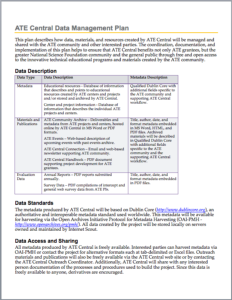Data Management Planning
Since 2011, the National Science Foundation (NSF) has required that applicants provide a one to two-page supplementary document, known as the Data Management Plan (DMP), to describe how a grantee’s proposal will meet NSF guidelines on the dissemination of grant-funded research. ATE Central can help you think through the various provisions of your plan—such as the storage, management, and distribution of data—and offers sustainability training and archiving services to all ATE projects and centers, free of charge.
Grantees who applied for and received funding under NSF solicitation 14-577 or later solicitation are expected to archive with ATE Central, as a requirement of the grant. To learn more about archiving with ATE Central or how to integrate ATE Central into your data management plan, please feel free to contact us at [email protected].
Content of the Data Management Plan

ATE PIs are expected to disseminate all major outcomes of their work produced with NSF funding; they are also asked to make available the data, samples, collections, or support materials created or collected during the course of their work, with some exceptions to confidential information. The goal of the DMP is, therefore, to show how your proposal conforms to NSF’s policies on dissemination. More specifically, your two-page data management plan should describe:
- Types of data, samples, physical collections, software, curriculum materials, and other materials to be produced in the course of the project;
- Standards to be used for data and metadata format and content (where existing standards are absent or deemed inadequate, this should be documented along with any proposed solutions or remedies);
- Policies for access and sharing including provisions for appropriate protection of privacy, confidentiality, security, intellectual property, or other rights or requirements;
- Policies and provisions for re-use, re-distribution, and the production of derivatives; and
- Plans for archiving data, samples, and other research products, and for preservation of access to them.
Tips on Creating a Data Management Plan
There are many avenues to dissemination and preservation, so take some time to explore all those available to you. Here are a few considerations to keep in mind while drafting your DMP:
- The types of data or information that your project or center is likely to generate;
- Where and how your data will be stored until you’re ready to share;
- Conditions that may limit access to your data (e.g. legal or ethical);
- The expectations or norms of your field that govern how you will share your deliverables;
- The options for dissemination available to (or required by) your institution; and
- Whether any other information should be documented (e.g. how data was collected, analyzed, etc.).
Resources on Data Management Planning and Access
NSF Frequently Asked Questions (FAQs) for Public Access
NSF Data Management Plan Requirements
NSF Proposal Preparation Instructions on the Data Management Plans
NSF Award and Administration Guide: Dissemination and Sharing of Research Results